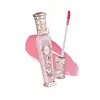What's inside
What's inside
 Key Ingredients
Key Ingredients

 Benefits
Benefits

No benefits
 Concerns
Concerns

 Ingredients Side-by-side
Ingredients Side-by-side

Hydrogenated Polyisobutene
EmollientDiisostearyl Malate
EmollientPolybutene
Caprylic/Capric Triglyceride
MaskingOctyldodecanol
EmollientBis-Diglyceryl Polyacyladipate-2
EmollientPolyglyceryl-2 Triisostearate
EmulsifyingDiphenyl Dimethicone
EmollientTrimethyl Pentaphenyl Trisiloxane
EmollientPhytosteryl/Octyldodecyl Lauroyl Glutamate
Skin ConditioningSilica Dimethyl Silylate
EmollientCeresin
Emulsion StabilisingSorbitan Isostearate
EmulsifyingCetyl PEG/PPG-10/1 Dimethicone
EmulsifyingDextrin Palmitate
EmulsifyingMica
Cosmetic ColorantVp/Hexadecene Copolymer
Dicalcium Phosphate
AbrasiveCI 77891
Cosmetic ColorantCI 45410
Cosmetic ColorantCI 19140
Cosmetic ColorantParfum
MaskingTocopheryl Acetate
AntioxidantCaprylyl Glycol
EmollientGlyceryl Caprylate
EmollientPolyglyceryl-2 Diisostearate
EmulsifyingTocopherol
AntioxidantCI 15850
Cosmetic ColorantCI 77499
Cosmetic ColorantHydrogenated Polyisobutene, Diisostearyl Malate, Polybutene, Caprylic/Capric Triglyceride, Octyldodecanol, Bis-Diglyceryl Polyacyladipate-2, Polyglyceryl-2 Triisostearate, Diphenyl Dimethicone, Trimethyl Pentaphenyl Trisiloxane, Phytosteryl/Octyldodecyl Lauroyl Glutamate, Silica Dimethyl Silylate, Ceresin, Sorbitan Isostearate, Cetyl PEG/PPG-10/1 Dimethicone, Dextrin Palmitate, Mica, Vp/Hexadecene Copolymer, Dicalcium Phosphate, CI 77891, CI 45410, CI 19140, Parfum, Tocopheryl Acetate, Caprylyl Glycol, Glyceryl Caprylate, Polyglyceryl-2 Diisostearate, Tocopherol, CI 15850, CI 77499
Dimethicone
EmollientVinyl Dimethicone/Lauryl Dimethicone Crosspolymer
Diisostearyl Malate
EmollientPolyglyceryl-2 Triisostearate
EmulsifyingTribehenin
EmollientSilica
AbrasiveQuartz
AbrasiveAlumina
AbrasivePolymethylsilsesquioxane
Sorbitan Isostearate
EmulsifyingCetyl PEG/PPG-10/1 Dimethicone
EmulsifyingVp/Hexadecene Copolymer
Tocopheryl Acetate
AntioxidantPhenoxyethanol
PreservativeCI 77492
Cosmetic ColorantCI 77491
Cosmetic ColorantCI 77499
Cosmetic ColorantCI 77891
Cosmetic ColorantCI 15850
Cosmetic ColorantCI 42090
Cosmetic ColorantDimethicone, Vinyl Dimethicone/Lauryl Dimethicone Crosspolymer, Diisostearyl Malate, Polyglyceryl-2 Triisostearate, Tribehenin, Silica, Quartz, Alumina, Polymethylsilsesquioxane, Sorbitan Isostearate, Cetyl PEG/PPG-10/1 Dimethicone, Vp/Hexadecene Copolymer, Tocopheryl Acetate, Phenoxyethanol, CI 77492, CI 77491, CI 77499, CI 77891, CI 15850, CI 42090
Ingredients Explained
These ingredients are found in both products.
Ingredients higher up in an ingredient list are typically present in a larger amount.
This ingredient is a high molecular weight silicone. It has emulsifying and skin conditioning properties.
Ci 15850 is the pigment color red. It is an azo dye and created synthetically.
Azo dyes need to be thoroughly purified before use. This allows them to be more stable and longer-lasting.
This ingredient is common in foundations, lipsticks, and blushes. This color is described as brown/orangey red.
It has many secondary names such as Red 6 and Red 7. According to a manufacturer, Red 6 usually contains aluminum.
Learn more about CI 15850Ci 77499 is also hydrated iron III oxide. It is created from mixing red and black iron oxides. This helps give shades of darkness to a product.
Iron III oxides are classified as inorganic chemicals for coloring.
Ci 77891 is a white pigment from Titanium dioxide. It is naturally found in minerals such as rutile and ilmenite.
It's main function is to add a white color to cosmetics. It can also be mixed with other colors to create different shades.
Ci 77891 is commonly found in sunscreens due to its ability to block UV rays.
Learn more about CI 77891Diisostearyl Malate is an emollient and most often used in lip products. It comes from isostearyl alcohol, a fatty acid, and malic acid, an AHA.
As an emollient, Diisostearyl Malate helps create a thin film on your skin to trap moisture in. This helps keep your skin soft and smooth.
This ingredient is a form of glycerin with emulsifying and emollient properties.
As an emulsifier, this ingredient helps keep products together while adding a thick texture. The manufacturer states this ingredient has emollient properties. Emollients help keep the skin hydrated by trapping moisture in.
Polyglyceryl-2 Triisostearate is created by reacting diglycerin and isostearic acid. Due to the isostearic acid base, it may not be safe for Malassezia or fungal acne.
Learn more about Polyglyceryl-2 TriisostearateSorbitan Isostearate is an emulsifer and cleaning agent. It is created from isostearic acid and sorbitol.
As an emulsifier, Sorbitan Isostearate prevents oils and water from separating.
Due to its isostearic acid base, it may not be safe for Malassezia or fungal acne.
Learn more about Sorbitan IsostearateTocopheryl Acetate is AKA Vitamin E. It is an antioxidant and protects your skin from free radicals. Free radicals damage the skin by breaking down collagen.
One study found using Tocopheryl Acetate with Vitamin C decreased the number of sunburned cells.
Tocopheryl Acetate is commonly found in both skincare and dietary supplements.
Learn more about Tocopheryl AcetateVP/Hexadecene Copolymer is a synthetic film-forming agent. It has both water and oil loving properties, allowing it to create a flexible, even film on the skin.
This ingredient helps enhance texture, smoothness, and wear resistance in makeup products while reducing tackiness.